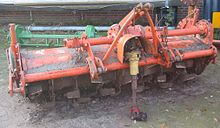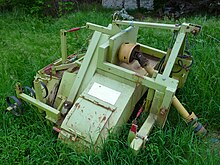Tiller (tillage)
The cutter is a harrow . It can be used in addition to or instead of the plow or other tillage equipment. Organic material ( crop residues , green manure ) can also be worked in with the tiller ; By milling, more oxygen gets into the soil , so that organic matter is broken down more quickly. In light to medium-heavy soils, it enables a finished seed to be produced in one operation.or to prepare a plant bed. The slower the tiller is driven and the faster the tiller shaft rotates, the finer the soil is loosened. Too frequent milling is problematic as it can lead to a segregation of the grain fractions of the soil.
Structure and functionality
The milling machine is attached either to a two- wheel tractor or to the three-point hydraulic system of a tractor and is driven by its engine by means of a PTO shaft. The cutter blades, which are usually around 15 cm long and angled at the outer end, rotate around a horizontal shaft (cutter shaft) in the direction of rotation of the tractor wheels. The milling knives also cut deeply rooted earth out of the soil and throw it against a baffle plate, which loosens, crumbles and mixes the soil. The tiller is one of the few agricultural implements that do not need the tractor to pull, but brake the tractor to enable more intensive cultivation of the soil. The actual milling machine is usually surrounded by a housing to avoid accidents. The soil can usually be processed up to a depth of around 15 cm with milling, but there are also designs with a particularly large diameter of the milling drum that allow processing depths of up to around 30 cm.
With patent specification 18/137/20 of August 6, 1921, the milling machine was patented for Arthur Clifford Howard in Australia.
A similar device is the tiller .
Reverse milling machine
The reverse milling machine is a special design in which the milling shaft rotates in the opposite direction to the direction of rotation of the tractor wheels. The soil cut out by the milling knives is thrown against a sieve, whereby stones or coarse plant residues are separated from the fine soil and then covered by it. In this way you get a finely crumbled seedbed free of stones and other disruptive material.
Ridger
The ridge cutter is another special type of construction and is used in asparagus and potato cultivation to create the ridges in which the plants grow. In potato growing, tillage, planting and ridge formation are often combined in one machine ( all-in-one process ). This combination reduces ground pressure, labor and energy consumption. The water available on the ground is also conserved. Furthermore, by placing the potatoes in the middle of the dam, the amount of green in the crop is reduced to a minimum.
Individual evidence
- ↑ Ulrich Sachweh (ed.): The gardener, Volume 3, tree nursery, fruit growing, seed growing, vegetable growing . 2nd edition, Ulmer, Stuttgart 1986/1989, ISBN 3-8001-1148-9 , p. 15



